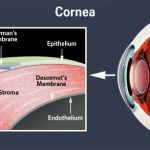CORNEAL TRANSPLANT
The diseases which affect the transparency of the cornea often lead to a loss of vision. In these cases the only viable recourse is to replace the damaged cornea with a transparent one. This is what is called a corneal transplant or keratoplasty and is a technique which allows patients to obtain a considerable improvement in their vision.
What is the cornea ?
The cornea is an external covering of the eye, which is situated above the iris and the pupil.
It is characterized by its transparency and that it allows light to pass towards the retina, where the visual process begins. When a disease affects this transparency, there occurs an interference in the passing of light and the final result is a loss of vision.
When is a corneal transplant recommended ?
It is recommended when there is a serious infection, lesion, damage, degeneration or scarring of the cornea ; when the cornea becomes opaque and does not permit light to pass through. In other cases the cornea remains transparent but has deformities which make vision difficult, as is the case of keratoconus, where a transplant is necessary to reestablish good vision.
What does a corneal transplant consist in ?
To perform a corneal transplant it is necessary to have at our disposal a donor cornea, which reaches the surgeon through an Eye Bank. The procedure consists in removing the damaged piece of cornea and replacing it with the equivalent piece of the donor cornea. This type of surgery is usually performed on an outpatient basis with local anesthetic, meaning that the patient is able to return home the same day they have been operated on.
Are there different techniques or types of corneal transplant ?
Depending on the part of the cornea that we are going to transplant, we can refer to one type of transplant or another.
Lamellar corneal transplant is the type which is performed when the most affected part of the cornea are the superficial layers and consists in the substitution of the epithelium, the Bowman’s membrane and part of the stroma. We could define this as a partial corneal transplant.
Posterior lamellar keratoplasty is the type of transplant that is done when the part of the cornea which is most affected are the deepest layers , the Descemet’s membrane and the endothelium.
The final objective with these two types of anterior transplants is to eliminate the least quantity of corneal tissue.
A penetrating corneal transplant consists in the substitution of the corneal tissue in its entirety, including the Descemet’s membrane and the endothelium.
What happens after the transplant ?
We must be extremely vigilant after the operation to avoid and control any rejection of the donor tissue, one of the most feared complications with any type of transplant. As far as the recuperation of vision goes, this can take several months depending on the degree of scarring and the state of health of the eye.
Could I be a cornea donor ?
The advantage of a corneal transplant is that there need not be any compatibility studies, which means that all of us could be potential donors. Excluded would be patients with infectious diseases, such as AIDS and hepatitis and those people who have undergone ophthalmological interventions. In Eye Banks an exhaustive analysis is carried out on donor corneas, selecting those which are valid for transplanting




